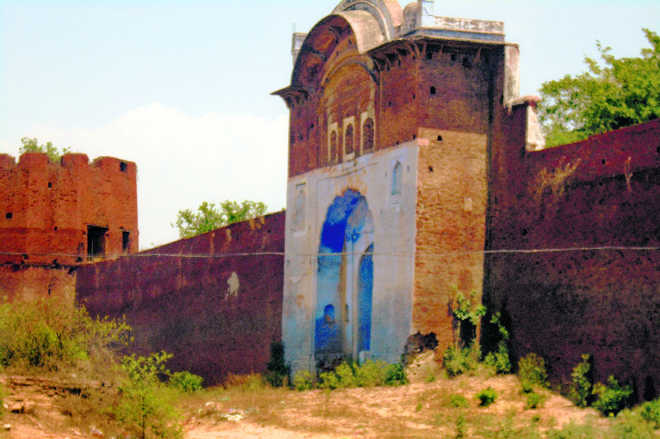Raja Sher Singh — Haryana’s first martyr
Virender Singh Dhillon
On the eve of the 150th year of the 1857 uprising, the Haryana Government in 2007 had decided to celebrate September 23 as ‘Haryana Veer and Shahidi Diwas’ as a mark of respect to the martyrs and freedom fighters. On this day (September 23) in 1857, Rao Tula Ram made the supreme sacrifice of his life fighting against the British. The first Punjabi Raja (then Haryana was part of Punjab), who sacrificed his life for the protection of his motherland, was Raja Sher Singh of Buriya. On December 18, 1804, the lion-heart Raja fought against British General Colonel Burn in the Battle of Saharanpur, was fatally wounded and finally made the supreme sacrifice of his life for his “watan” (country).
Cambridge historian CA Bayly used the term, ‘Traditional Patriot’ for such Rajas and the concept of ‘Traditional Patriotism’ is his contribution to the understanding of the nature of past feelings of nationalism against the colonial rule. Even celebrated British administrator historian Sir Lepel Henry Griffin, the author of the book “The Rajas of the Punjab”, acknowledged in 1870 the valour and struggle of Raja Sher Singh against the British in his monograph. He writes, “If there be any feeling of nationality in India whatever, it may be most fairly looked for among the Sikhs”.
Raja Sher Singh assisted Rohilla chief Amir Khan and Maratha Sardar Jaswant Rao Holkar when they were struggling against the British in north India. The official communication (letters written between British commanders Lord Lake, Colonel David Ochterlony and Colonel Burn at Delhi, Meerut, and Saharanpur, respectively, during 1804-05) highlights the trouble caused by Raja Sher Singh and other Khalsa Sardars in the region of Saharanpur across the Yamuna to counter the invasive tendencies of the British. The house of Buriya chiefship was founded by Sardar Nanun Singh, a Jat from Jhawal Mandan village in the Majha area of Punjab in 1764. He along with his brothers Bhag Singh and Rai Singh seized the fort of Buriya from Narwaria Sikhs, who had captured it after its abandonment by Lachmi Narain, an officer of Zain Khan, Mughal Governor of Sirhind.
Sardar Nanun Singh and his brothers all belonged to the ‘Bhangi Misl’ of the Khalsa panth. The Narwaria Sikhs colluding with the Afghans of Aurangabad (a village near Damla in Yamunanagar) enticed Nanun Singh and Bhag Singh to the Aurangabad Fort, and put them to death. Rai Singh and Bhag Singh, the adopted son of Nanun Singh, avenged their relatives’ death and seized more territory in all 204 villages, which they divided between themselves. Rai Singh took 84 villages forming his estates of Jagadhri and Dyalgarh while Bhag Singh took 120 villages forming the estate of Buriya.
Bhag Singh died in 1785 and his son, braveheart Raja Sher Singh, was crowned as his successor. Raja Sher Singh ruled for 19 years (1785 to 1804) before his supreme sacrifice of his life in the Battle of Saharanpur in 1804. The total revenue of the Buriya estate was around Rs 2.17 lakh. The regular military strength of the Buriya chief was 330 horsemen and 495 foot soldiers. The estate of Jagadhri lapsed to the British in 1829 while the estate of Buriya lapsed by the reforms of 1849 when it was acquired by the British through the Mughal principle of Escheat.
Raja Sher Singh was a great fighter, who fought along with other Sikh Sardars against Afghan invader Zaman Shah, the grandson of Ahmad Shah Abadali. Raja Sher Singh had two sons Raja Gulab Singh and Sardar Zalam Singh. Raja Gulab Singh succeeded his father to the throne of Buriya. The resources of the Buriya state under Raja Gulab Singh in 1808 were 600 cavalry and a revenue income of one lakh rupees. The military force of the Buriya state was reduced by the British from 6,000 cavalry to 825, out of which there were 330 horsemen and 495 foot soldiers.
When the Buriya state was formed, its revenue resources were 2.17 lakh silver rupees collected in the form of duties, octroi and land revenue. Duties in the form of octroi and ‘Rahadari’ were collected in the Buriya estate at Buriya, Jagadhri, Mikrood, Jittabuh, Tigru, Bughat, Rajghat and Chowki Damloh amounting to 42,200 silver rupees. The land revenue collection from 204 villages of the Buriya estate was 1.75 lakh silver rupees.
Buriya Fort
The Buriya Fort built during the time of Shah Jahan (1628-1658) was in possession of Mughal officer Lachmi Narain, an officer of Zain Khan, the Mughal Governor of Sirhind. In 1763, Zain Khan was killed by the Sikhs in the Battle of Sirhind and Lachmi Narain sometime after getting the news of his master’s defeat abandoned the fort, which was captured by Narwaria Sikhs. Nanun Singh along with his brothers Bhag Singh and Rai Singh captured the fort of Buriya from the Narwaria Sikhs in 1764.
Gladstone Gate: This gate was constructed in 1870s by Raja Jiun Singh of Buriya for welcoming the then Deputy Commissioner of Ambala, Gladstone, who awarded the ‘sanad’ of Buriya Jagir and First Class Judicial Magistrate Rights to the Raja. After Partition, due to large exodus of Muslims from Buriya and the arrival of Hindu migrants from newly founded Pakistan, its marble plaque was changed as ‘Raja Birbal Gate’, though Raja Birbal had no connections with Buriya.
(The writer teaches history at Maharaja Agrasen College, Jagadhri)









